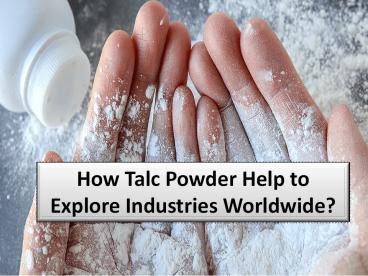Talc Powder for Ceramic Industry - PowerPoint PPT Presentation
Title:
Talc Powder for Ceramic Industry
Description:
Manufacturers provide customers with talc powder for the ceramic industry at competitive prices that are unpaired in the industry. Talcum powder manufacturers also have the additional benefit of stabilizing release shrinkage. – PowerPoint PPT presentation
Number of Views:60
Title: Talc Powder for Ceramic Industry
1
How Talc Powder Help to Explore Industries
Worldwide?
2
What is Talc?
- Talc is the softest mineral on the planet.
Despite the fact that all talc ores are soft,
platy, water resistant, and chemically inert, no
two talcs are exactly same in their properties.
Talc is an essential component of daily living.
Talc is used to improve a variety of items,
including the periodicals we read, the plastics
in our vehicles and homes, the paints we use, and
the tiles we walk on. Talc is a cosmetic
component that may be found in a variety of
products, from baby powder to blush. - Talc is a hydrated magnesium sheet silicate
having the chemical formula Mg3Si4O10(OH)2 and
the physical properties of a hydrated magnesium
sheet silicate. The elementary sheet is made up
of a layer of magnesium-oxygen/hydroxyl octahedra
sandwiched between two layers of silicon oxygen
tetrahedra, with the layer of magnesium-oxygen/hyd
roxyl octahedra on top of the other. Since talc
does not contain hydroxyl groups or active ions,
its hydrophobicity and inertness may be explained
by the absence of active ions or hydroxyl groups
on its main or basal surfaces.
3
Talc Powder for Ceramic Industry
- Talc powder for ceramic industry is a
fine-grained talc powder that we provide for
sale. Talc powder manufacturers has undergone
extensive testing to ensure that it meets the
highest standards of quality. Manufacturers
provide customers with talc powder for ceramic
industry at competitive prices that are unmatched
in the industry. In addition, we make certain
that the talc powder for ceramic industry is
packaged appropriately, using the finest packing
material available. - Talc powder is the primary ingredient of
cordierites, steatites, and earthenware, among
other types of ceramics. It is also utilised as
an ingredient in a variety of products, including
floor and wall tiles, dinnerware, and sanitary
products. Talcum powder, when combined with
feldspar to generate a eutectic-flux, lowers the
firing temperatures and minimises the number of
firing cycles. Talcum powder manufacturers also
has the additional benefit of stabilising firing
shrinkage.
4
Talc Is Used In A Variety Of Industrial
Applications
- The five properties that distinguish talc as a
desirable mineral for industrial and household
uses are as follows first, its softness, which
makes it important to industry second, its
chemically inertness third, its lamellarity
fourth, its white and fifth, its friendliness
for organic chemicals - Uses
- Thermal shock in clay bodies should be minimised.
- Ceramic Pottery and Ceramic Glazes are two types
of ceramic art. - Produce matte and opaque glazes using this
technique. - It is possible to decrease crazing in glazes
applied on earthenware clay bodies. talcum powder
is also used as a deodorant and for a variety of
other cosmetic purposes. In addition to being
used to treat diaper rash it may be made of talc
(in which case it is referred to as talcum
powder) or corn starch, depending on the
formulation. It is often used as a bulking agent
in counterfeit medications and food goods in
order to provide the impression of a greater
amount than is really contained in the product.
5
- However, unlike silicate minerals such as
limestone, asbestos is a silicate mineral with a
distinct crystal structure. Talc and asbestos are
both naturally occurring minerals that may be
found in close proximity to one another in the
earth's crust. As opposed to talc, asbestos is a
recognised carcinogen when breathed, but talc is
not. As a result, it is critical to carefully
identify talc mining locations and to take
efforts to thoroughly test the ore for asbestos
contamination before mining begins.
6
(No Transcript)































